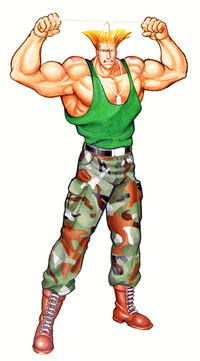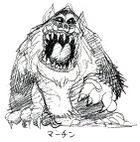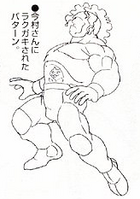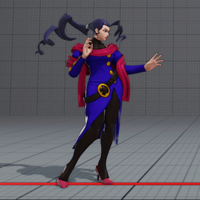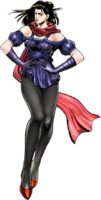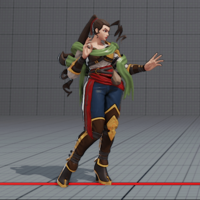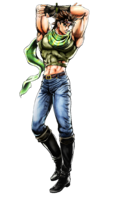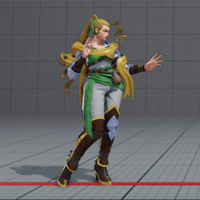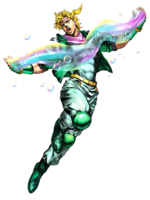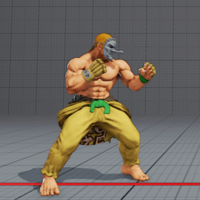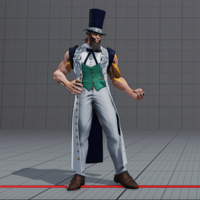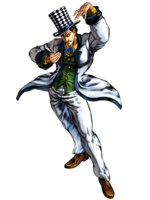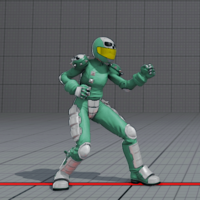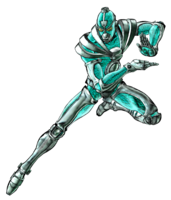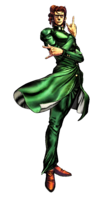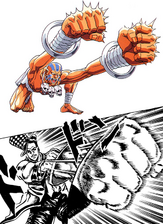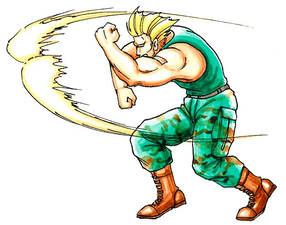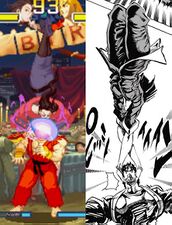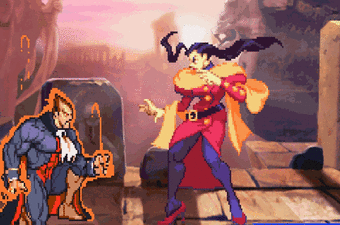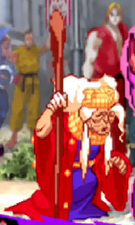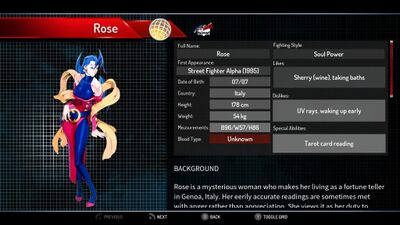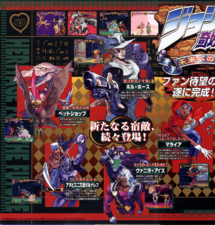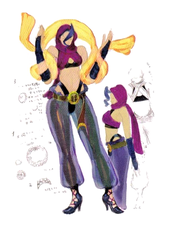Street Fighter
Street Fighter (ストリートファイター, Sutorīto Faitā) is a popular fighting game series developed and published by Capcom. The first game in the series was released in 1987, followed by five other main series games, various spin-offs, crossovers, and numerous appearances in other media. Its best-selling 1991 release Street Fighter II is credited with establishing many of the conventions of the one-on-one fighting genre.
The series has made multiple references to JoJo's Bizarre Adventure, as well as taking inspiration from several of the designs used in the series. The most notable of which are the character designs for fighters Guile and Rose.
Summary
Street Fighter II

Street Fighter II: The World Warrior (ストリートファイターII -The World Warrior-, Sutorīto Faitā Tsū -Za Warudo Uōria-) was first released by Capcom for Japanese arcades on February 6, 1991. It is the second game in the main Street Fighter series and is widely considered one of the most important and influential fighting games ever made, sparking the fighting game boom during the early 1990s.
Producer Noritaka Funamizu revealed in an interview that Guile's overall appearance in Street Fighter II was modeled after Jean Pierre Polnareff from Stardust Crusaders.[1] Funamizu also explains that Guile's name originates from Polnareff's archenemy, J. Geil,[a] though this was said to be the result of a mix up from the development staff at the time.[1] Funamizu said, "We chose the names very carelessly. It started with an Indian, a jungle savage, a Chinese woman, and so on. Guile was the only one that we started to design after choosing the name. One of the people who saw the rough sketch for him said, 'Oh, this is Geil from JoJo's Bizarre Adventure, right?', so we thought, 'Alright then, let's go with Guile.' We looked it up afterward, and it turned out to be Polnareff (laughs)."[1] Furthermore, according to series planner, Akira Yasuda, who was in charge of character designs at the time, early drafts of Guile included Polnareff's vertical, yet modest, hairstyle. However, when the sprites were being made for the game, the pixel artist jokingly stretched Guile's hair out to the sides. The team found this amusing and decided to give him the "always distinctive Stroheim look" instead.[2] During some point in development of Street Fighter II, Guile's iconic Sonic Boom was also called the Divine Sandstorm (神砂嵐, Kamizuna Arashi). According to developer comments, this was likely a reference to the character Wamuu, who also uses a wind attack of the same name.[3][4]
The concept of Dhalsim's ability to stretch his limbs in Street Fighter II were also inspired by Zeppeli's Zoom Punch technique, as revealed by the lead designer Akira Nishitani in an interview with Polygon.[5] This was further confirmed by Akira Yasuda, who mentioned that Dhalsim's Zoom Punch was originally going to have him extend his arms in a "JoJo-style" effect early on in development.[2] According to character designer for Super Street Fighter II, Akiko Ohnishi, JoJo's Bizarre Adventure was the most popular manga among Capcom staff at the time.[6] Ohnishi also commented, "For a while now, every time we do a little survey for fun, JoJo always ends up #1 on the list for favorite manga. We also had a lot of people surprisingly answer the survey wanting to make a JoJo game."[6]
Street Fighter Alpha
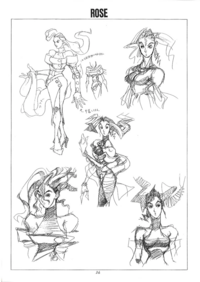
Street Fighter Alpha: Warriors' Dreams, known as Street Fighter Zero (ストリートファイターZERO, Sutorīto Faitā Zero) in Japan, was released for Japanese arcades on June 5, 1995. It is the third game in the main Street Fighter series and is a prequel set between the first and second games.
A sequel for the game titled Street Fighter Alpha 2, or Street Fighter Zero 2 (ストリートファイターZERO/2, Sutorīto Faitā Zero Tsū) in Japan, was released for arcades in Japan on February 27, 1996.
It was also later followed by a third game named Street Fighter Alpha 3, or Street Fighter Zero 3 (ストリートファイターZERO/3, Sutorīto Faitā Zero Surī) in Japan, released June 29, 1998.
One major character introduced in the Street Fighter Alpha series is Rose, a fortune-teller who wields a unique energy called Soul Power. Rose's character design and abilities were inspired by Lisa Lisa from Battle Tendency as confirmed in a video released by Capcom UK.[7] Both Rose and Lisa Lisa share nearly identical outfits and employ a fighting style that involves channeling energy through their scarves; Soul Power in Rose's case, and the Ripple in Lisa Lisa's case. Furthermore, both characters have a fondness for taking baths.[b]
In Street Fighter: Alpha 2, Rose's stage is set in Venice, the same location where Joseph and Lisa Lisa first met. Additionally, Rose's Soul Drain move throughout the series resembles the pose that Lisa Lisa makes while putting the Ripple Breathing Mask on Joseph. In the game Capcom Fighting Evolution, Rose can be transformed into a masked gondolier reminiscent of Lisa Lisa's first appearance using Demitri's Midnight Bliss attack. There's also a rare chance that she will transform into Enya the Hag, with sprites modified from the PlayStation port of JoJo's Venture. Coincidentally, the anime adaptation of Street Fighter Alpha 2, titled Street Fighter Alpha: Generations, was animated by A.P.P.P., the same studio that produced the JoJo's Bizarre Adventure OVA series.
Street Fighter III
Street Fighter III: New Generation (ストリートファイターIII -NEW GENERATION-, Sutorīto Faitā Surī -Nyū Jenerēshon-) was released for arcades in Japan on February 28, 1997. During early development of Street Fighter III, a concept sketch was created for an unused character named "Martin" whose name and appearance are directly based on Martin from Baoh the Visitor.[8]
Street Fighter III: 2nd Impact - Giant Attack (ストリートファイターIII セカンドインパクト GIANT ATTACK, Sutorīto Faitā Surī Sekando Inpakuto Jaianto Atakku) was released for arcades in Japan on October 18, 1997. A concept sketch for the character named "Hugo" in the "Secret Files" booklet shows a plant with a cat-like head within Hugo's abdomen, resembling Stray Cat being within Killer Queen's abdomen in Diamond is Unbreakable.
Furthermore, the same team behind Street Fighter III would also go on to develop the game JoJo's Venture for the CP System III. One of the main illustrators for the Street Fighter series, Bengus, also illustrated character artwork used in flyers to promote the game JoJo's Bizarre Adventure: Heritage for the Future.[9] Another connection to the Street Fighter series can be found in the animation used for round announcements in the international versions, as the ripple effect is borrowed from a frame used in Ryu's Shin Shoryuken move from Street Fighter III.
Street Fighter IV
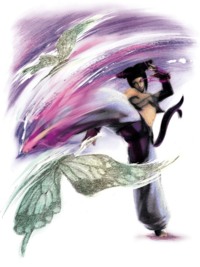
Street Fighter IV (ストリートファイター IV, Sutorīto Faitā Fō) was developed by Capcom and Dimps and published by Capcom for arcades in Japan on July 18, 2008. It is the fifth game in the main Street Fighter series and the first main series entry to include 3D models and backgrounds similar to the Street Fighter EX series. An updated version of the game titled Super Street Fighter IV was released as a standalone title in April 2010, introducing the South Korean female Taekwondo fighter, Juri Han. The second update to the game, Ultra Street Fighter IV, was released on April 18, 2014.
Rose also reappears in Street Fighter IV, where her first alternate costume appears to be inspired by the character Moriah from Capcom's Dungeons & Dragons: Shadow over Mystara, whose namesake and appearance likely come from Mariah in Stardust Crusaders.[10] Rose's profile on the Street Fighter IV website also states that she likes "taking baths", which is a reference to Lisa Lisa's profile on the cover of Chapter 97 and her ending in Street Fighter Alpha 2.[11][12] Rose's voice actress in the later games, Akeno Watanabe, also voices Miuccia Miuller in Eyes of Heaven and Gloria Costello in the Stone Ocean anime.
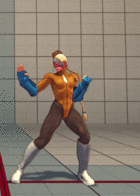
In Super Street Fighter IV, aspects of Juri's design, such as her hair and chest wear, resemble Jolyne Cujoh from Stone Ocean. In addition, Juri has a spider motif and cleaves a butterfly in her official artwork; Jolyne has a butterfly motif, and her Stand, Stone Free, turns her body into threads and webs, in addition, she also has spiderweb-patterned clothes. Juri's "Hora Hora Hora!" battle cry when using her Fuharenjin attack is also similar to Jolyne's "Ora Ora Ora!". Coincidentally, Jolyne's voice actress in All-Star Battle and Eyes of Heaven, Miyuki Sawashiro, shares voices with Cammy in Street Fighter IV and Street Fighter V. Juri's Japanese voice actress, Eri Kitamura, also voices Yasuho Hirose in both games respectively. In Ultra Street Fighter IV, Decapre has a taunt identical to Muhammad Avdol's "Yes! I am!" pose from Stardust Crusaders. It can be selected by picking Decapre's Personal Action 10 from the character select screen. When Decapre's Personal Action 9 is selected, she will say "Useless!" (無駄, Muda) while taunting, in reference to Dio Brando. Decapre is also voiced by Jolyne's voice actress, Miyuki Sawashiro.
Street Fighter V
Street Fighter V (ストリートファイターV, Sutorīto Faitā Faibu) was developed by Capcom and Dimps and published by Capcom for the PlayStation 4 and Microsoft Windows on February 16, 2016. It is the sixth game in the Street Fighter series and the first game in the series to not initially be released in arcades. An update to the game titled Street Fighter V: Arcade Edition was released on January 16, 2018, and a second update titled Street Fighter V: Champion Edition was released on February 14, 2020.
In Street Fighter V, the DLC character Seth has many moves based on older Capcom fighting games, including JoJo's Venture. His Hecatoncheires move is based on Jotaro and DIO's Blazing Fists, with the EX version of the attack ending with Jotaro's Star Breaker as Seth yells "Ora Ora Ora!". Seth also imitates The World's punch and DIO's Time Stop pose after performing his Titanomachy special move. Seth's voice actor in Street Fighter IV and Street Fighter V, Akio Otsuka, also voices Wamuu in various media and Muhammad Avdol in the JoJo's Bizarre Adventure Drama CD.
Rose returns as a DLC fighter for the fifth season of the game. In the Japanese version, Rose will say the line "Gimme a break!" (やれやれだわ, Yare yare dawa) during her taunt animation, which is a reference to Jolyne's catchphrase in Stone Ocean.[13] The English dub of the game replaces this line with "You reap what you sow." One of Rose's alternate colors for her default outfit is also directly based on Lisa Lisa. Her masked gondolier outfit inspired by Lisa Lisa also returns from the game Capcom Fighting Evolution as her "Nostalgia" costume. Rose's "Battle Outfit" also contains colors reminiscent of Joseph and Caesar from Battle Tendency. Alongside Rose, many other DLC characters feature alternate colors that are similar to JoJo characters. One of Dan's colors for his "Battle Outfit 1" costume is possibly a reference to Dio Brando with his mask reminiscent of the Stone Mask. One of G's colours for his default costume has him wearing a white suit and green vest similar to Will Anthonio Zeppeli. The Rival Schools guest DLC fighter, Akira Kazama debuts alongside her brother Daigo Kazama, who appears as part of her V-Trigger and Critical Art. One of Akira's colors for her "Story" costume has her wearing a biker outfit similar to Hierophant Green, with Daigo resembling Noriaki Kakyoin.
Street Fighter 6
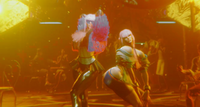
Street Fighter 6 (ストリートファイター6, Sutorīto Faitā Shikkusu) is the sixth game in the Street Fighter series, released on June 2, 2023. In Street Fighter 6, the character Manon does a pose similar to Risotto Nero during her pre-fight animation. Her win animation is also similar to the cover of the first volume of Thus Spoke Kishibe Rohan.
Commentary
Gallery
Trivia
- Iggy's Sand Storm super move in JoJo's Venture is a reference to Akuma's "Raging Demon" move in the series. This is further evidenced in the game's debug mode, where an unused graphic shows the kanji for the word dog (犬, inu) stylized in a similar manner to Akuma's kanji for heaven (天, ten).[14]
Notes
References
| This page uses Creative Commons Licensed content from Wikipedia (view authors). |
- ↑ 1.0 1.1 1.2 Interview with Noritaka Funamizu - Weekly Famitsu Issue 1998/9/25
- ↑ 2.0 2.1 Street Fighter X Tekken Artworks
- ↑ Pen+ With New Attitude 30th Anniversary Edition
- ↑ moonq515@黄金体験 on Twitter
- ↑ Street Fighter 2: An Oral History - Polygon
- ↑ 6.0 6.1 Secret File Issue #23 - JoJo's Bizarre Adventure Dictionary
- ↑ The World Warriors 01 - You got to have soul! - YouTube
- ↑ "ストⅢの最初期のキャラデザインスケッチ(SHOEI)@akiman7 #カプコンアートワーク #SF35th #ストリートファイター", Capcom (@CAPCOM_AWT), November 3, 2022.
- ↑ ベンガス on Twitter: "わー 超懐かしい、私が描きました"
- ↑ Dungeons & Dragons: Shadow over Mystara - VGFacts
- ↑ Rose - Ultra Street Fighter IV Profile
- ↑ Street Fighter Alpha 2 Rose Ending - YouTube
- ↑ りょう@Street Fighter on Twitter
- ↑ イギー - ニコニコMUGENwiki - atwiki
